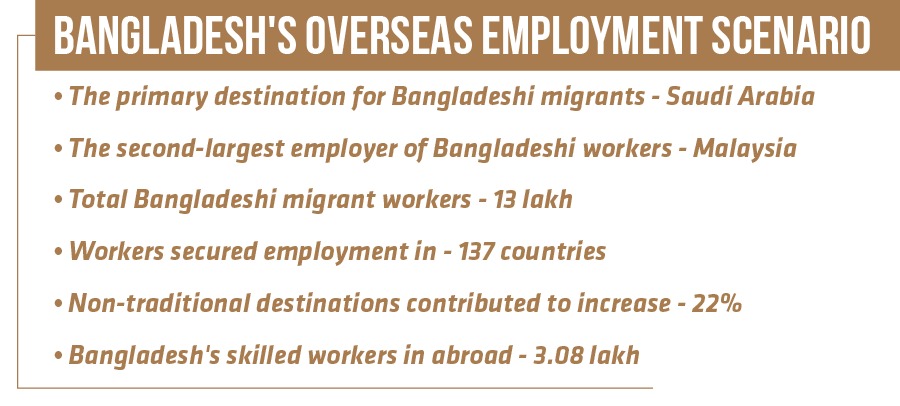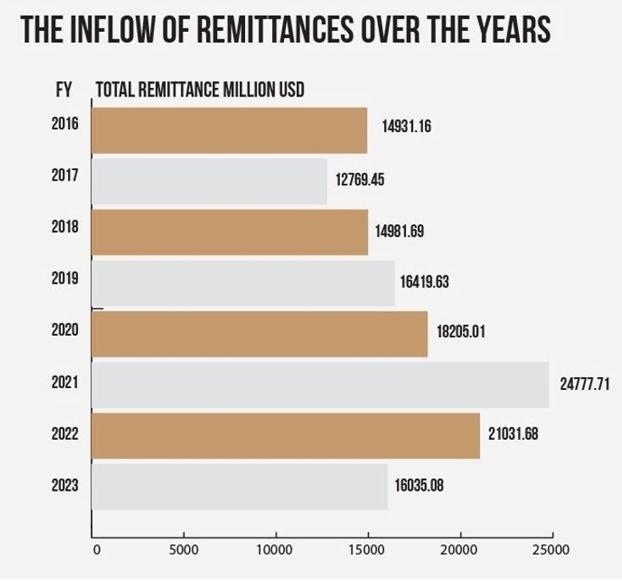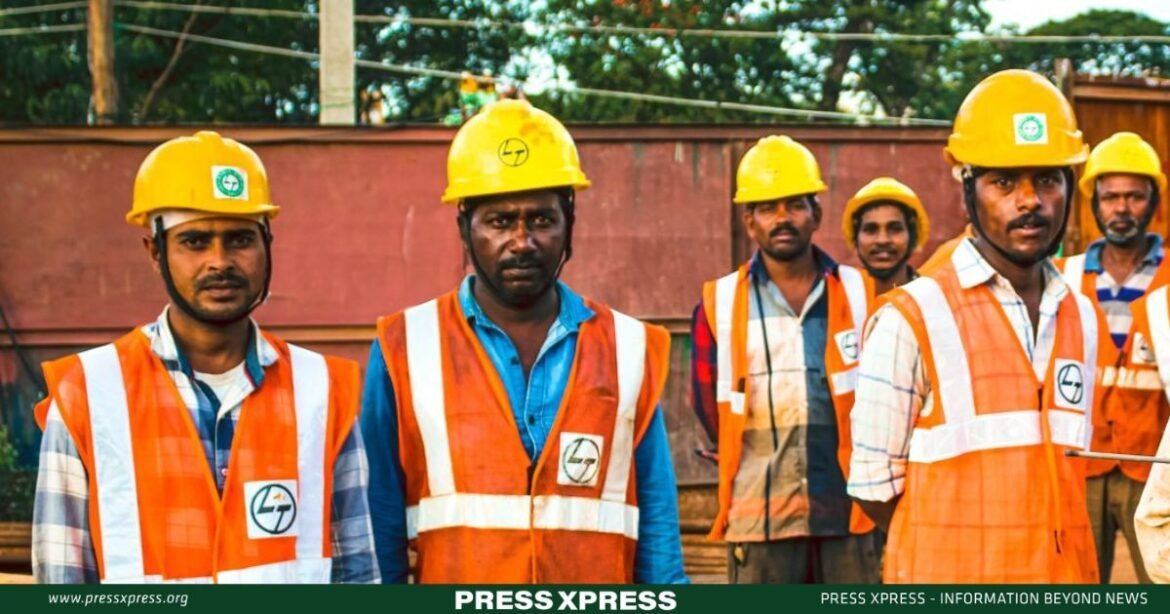The surge, fueled by reopened markets and expanded quotas, saw notable growth in traditional and non-traditional destinations
In 2023, there was a notable surge in labor migration, as indicated by data from the Bureau of Manpower, Employment, and Training (BMET) and Bangladesh Bank. The statistics reveal a 15.15% increase in labor migration compared to the previous year (2022), while the remittance flow experienced a modest 2.96% year-on-year (YoY) rise in 2023. By the conclusion of the 2023 calendar year, 1.31 million workers secured employment across 137 countries, surpassing the November 2023 figure of 1,210,256. This marked a substantial rise from the previous migration record of 1,135,873 in 2022, as reported by BMET. Bangladesh, according to Bangladesh Bank data, received $21.91 billion in remittances in 2023, exceeding the $21.28 billion received the preceding year. The latest data from the central bank indicates that expatriates sent home $1.99 billion in the final month of 2023, reflecting a 3.09% increase from November.
You can also read: Expatriates Fuel Bangladesh’s Development Globally

Record-Breaking Bangladesh’s Overseas Employment Scenario
In 2023, Bangladesh achieved a new milestone in overseas employment. This remarkable feat was attributed to the reopening of the Malaysian market and the expanded quotas in Saudi Arabia. According to data from the Bureau of Manpower, Employment, and Training (BMET), a total of 13 lakh workers secured employment in 137 countries, marking an increase from the 2022 record of 11.35 lakh. Malaysia, after a four-year hiatus, emerged as the second-largest employer of Bangladeshi workers globally, closely trailing behind Saudi Arabia. The Southeast Asian nation hired 3.51 lakh workers across various sectors, including manufacturing, construction, services, plantations, agriculture, mining, and household services.

Furthermore, the surge in hiring opportunities in Saudi Arabia can be attributed to the increased quota for Bangladeshi workers, rising from 25% to 40% in 2021. Saudi Arabia recruited the highest number of workers, reaching 4.98 lakh in 2023, constituting 38% of Bangladesh’s total foreign employment. The roles included construction workers, cleaners, masons, plumbers, and drivers. While the majority of overseas employment remained concentrated in traditional Middle Eastern markets, the record-breaking figures in 2023 also showcased a notable increase in non-traditional destinations. Italy emerged as the largest non-traditional employer, hiring 16,926 workers in agriculture, hospitality, and manufacturing. The UK and South Korea joined the list of major employers, recruiting 10,437 and 5,000 workers, respectively, in roles such as caregivers, domestic staff, hospitality personnel, and skilled workers.
A surge in non-traditional destinations contributed to a 22% increase in skilled worker migration by December 11, 2023, with Bangladesh sending 3.08 lakh skilled workers abroad, surpassing the 2022 mark of 2.52 lakh. However, unskilled migration continued to dominate, constituting 50% of total foreign jobs, while skilled migration accounted for approximately 25%, as reported by BMET.
Bangladesh’s Remittance Inflow
Bangladesh’s economy is primarily reliant on expat earnings, which are the country’s second-largest source of foreign exchange income. The following chart depicts the evolution of Bangladesh’s remittance inflows.

In November 2023, a Bangladesh Bank report revealed that remittances totaled 1977.56 million US dollars. Nevertheless, the most recent data from Bangladesh Bank discloses that the country received a total of $21.91 billion in remittances for the year 2023, surpassing the previous year’s figure of $21.28 billion. The central bank’s latest figures also indicate a 3.09% increase from November, with expatriates sending $1.99 billion back home in the final month of 2023.
Impacts of Remittance on Bangladesh’s Economy
Migration serves as a significant driver of Bangladesh’s national economy through two crucial avenues: firstly, by addressing unemployment, and secondly, by fostering the flow of remittances. The consistent rise in migration has proven advantageous for the country’s progress, as reflected in the annual increase in remittance inflows. The intrinsic link between migration and remittances is apparent, both playing a pivotal role in mitigating poverty within the homeland. Remittances have emerged as a fundamental catalyst for socioeconomic advancement in developing nations such as Bangladesh, contributing significantly to balancing payments and fortifying foreign currency reserves. Furthermore, these remittances have a substantial impact on the country’s Gross Domestic Product (GDP). As migration gains recognition as a viable development option, particularly for the less educated and unskilled workforce, it holds the potential to uplift families at the grassroots level.
Top Remittance Recipient Countries

According to the latest World Bank report, Bangladesh ranks as the 7th largest recipient of remittances globally. In 2023, India leads the pack with an estimated $125 billion, followed by Mexico at $67 billion, China at $50 billion, and the Philippines at $40 billion. Egypt and Pakistan both share the same position, receiving $24 billion each. Nepal maintains its status as the South Asian country with the highest proportion of remittances relative to GDP, standing at 27 percent. In contrast, Sri Lanka and Pakistan have remittances accounting for approximately 7 percent of their GDP, while Bangladesh records 5.2 percent in 2023. Sri Lanka experienced a surge in remittance inflows this year, attributed to the restoration of macroeconomic stability and a positive response from migrants due to the effects of an IMF-supported program. After a consistent downturn over the past two years, remittances to Sri Lanka are projected to steadily climb, reaching $6 billion in 2024.
Conclusion
In 2023, Bangladesh achieved record-breaking overseas employment with 1.31 million workers securing jobs across 137 countries. The surge, fueled by reopened markets and expanded quotas, saw notable growth in traditional and non-traditional destinations. Remittance inflows reached $21.91 billion, solidifying migration’s pivotal role in Bangladesh’s economic development and global remittance rankings.


